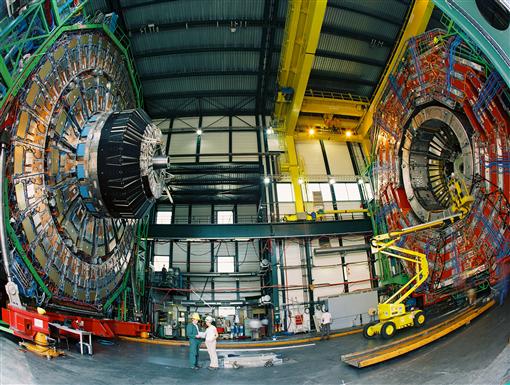
Two experimental collaborations at the Large Hadron Collider, located at CERN laboratory near Geneva, Switzerland, announced today that they have significantly narrowed the mass region in which the Higgs boson could be hiding.
The ATLAS and CMS experiments excluded with 95 percent certainty the existence of a Higgs over most of the mass region from 145 to 466 GeV (giga, or billion, electron volts). They announced the new results at the biennial Lepton-Photon conference in Mumbai, India.
The Higgs particle is the last not-yet-observed piece of the theoretical framework known as the Standard Model of particles and forces. According to the Standard Model, the Higgs boson explains why some particles have mass and others do not.
"Each time we add new data to our analyses, we close in more on where the Higgs might be hiding," said Darin Acosta, a University of Florida professor and deputy physics coordinator for the CMS (Compact Muon Solenoid) experiment.
"This is a really significant result and I would say that in a way, it's the most important result that has emerged since the Large Hadron Collider came into operation a year and a half ago," said Greg Snow, professor of physics and astronomy at UNL, founding member of UNL's experimental high-energy physics team, and a collaborator on the CMS experiment since 1993.
"What it means is we're starting to narrow down the mass range where the Higgs particle can live to this region and that region. And that's really going to help us with the data analysis and the way we take data at the experiments at the Large Hadron Collider over the next few years."
UNL's experimental high-energy physics team includes four other faculty members, Ken Bloom, Dan Claes, Aaron Dominguez and Ilya Kravchenko, and several other researchers working in Lincoln, at CERN in Switzerland, and at the Fermi National Accelerator Laboratory in Batavia, Ill.
In addition, UNL is one of seven CMS Tier-2 sites in United States in the Worldwide LHC Computing Grid, the first truly worldwide grid computing infrastructure. The grid combines the computing power of more than 140 independent computer centers in 34 countries and supports the LHC experiments. Data has been transferred at peaks of 10 gigabytes per second, the equivalent of two full DVDs of data a second. Bloom serves as Tier-2 coordinator for the United States in the CMS experiment and is co-primary investigator on the UNL part of the project with Dominguez and computer scientist David Swanson, director of UNL's Research Computing Facility. Bloom is also deputy program manager for U.S. CMS software and computing.
"The more data the experiments collect, the more scientists can say with greater statistical certainty," said Konstantinos Nikolopoulos, a physicist at Brookhaven National Laboratory on the ATLAS experiment.
"The LHC has been providing that data at an impressive rate. The machine has been functioning beyond expectations."
Scientists on ATLAS and CMS both announced seeing small, possible hints of the Higgs boson in the same mass range at the European Physical Society meeting in July. Those hints have become less pronounced as scientists have increased the amount of data in their analysis.
"These are exciting times for particle physics," said CERN's research director, Sergio Bertolucci. "Discoveries are almost assured within the next twelve months. If the Higgs exists, the LHC experiments will soon find it. If it does not, its absence will point the way to new physics."
The experiments are on track to at least double the amount of data they have collected by the end of the year.
More than 1,700 scientists, engineers and graduate students from the United States collaborate on the experiments at the LHC, most of them on the CMS and ATLAS experiments, through funding by the Department of Energy Office of Science and the National Science Foundation. Brookhaven National Laboratory serves as the U.S. base for participation in the ATLAS experiment, and Fermi National Accelerator Laboratory serves as the U.S. base for participation in the CMS experiment.
- Tom Simons, University Communications; and Kathryn Grim, U.S. LHC Communications
More details at: http://www.youtube.com/watch?v=rF6DVKECwXo